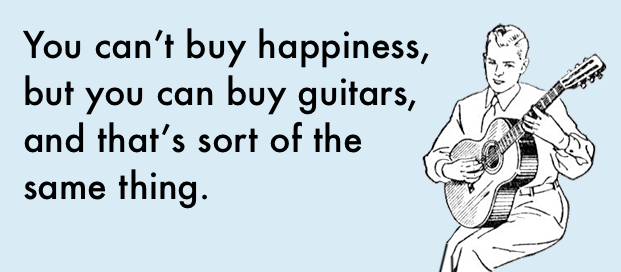Entries in guitar (97)
The environmental politics of Sitka spruce
I recently visited the Martin guitar factory; it was my 5th time taking the tour, but my first time on the 2-hour "behind the scenes" tour. I first visited Martin when I first moved to the east coast 12 years ago. At some point I'll write more about the transformations that I've seen there over the last decade. But for now, one thing that is clear: things in the tonewood world are changing. I recommended checking out the documentary previewed above, Musicwood (see my previous thoughts on environmentalism and guitars here). While this film focuses on future of Sitka spruce, this is something industry has confronted in the past (e.g., rosewoods from Brazil and Madagascar), with increasing frequency manufacturers and consumers will have to adjust their expectations.
 Wednesday, November 13, 2013 |
Wednesday, November 13, 2013 |  Post a Comment | tagged
Post a Comment | tagged  environmentalism,
environmentalism,  gibson,
gibson,  guitar,
guitar,  martin,
martin,  taylor
taylor Photo of the week - November 12, 2013
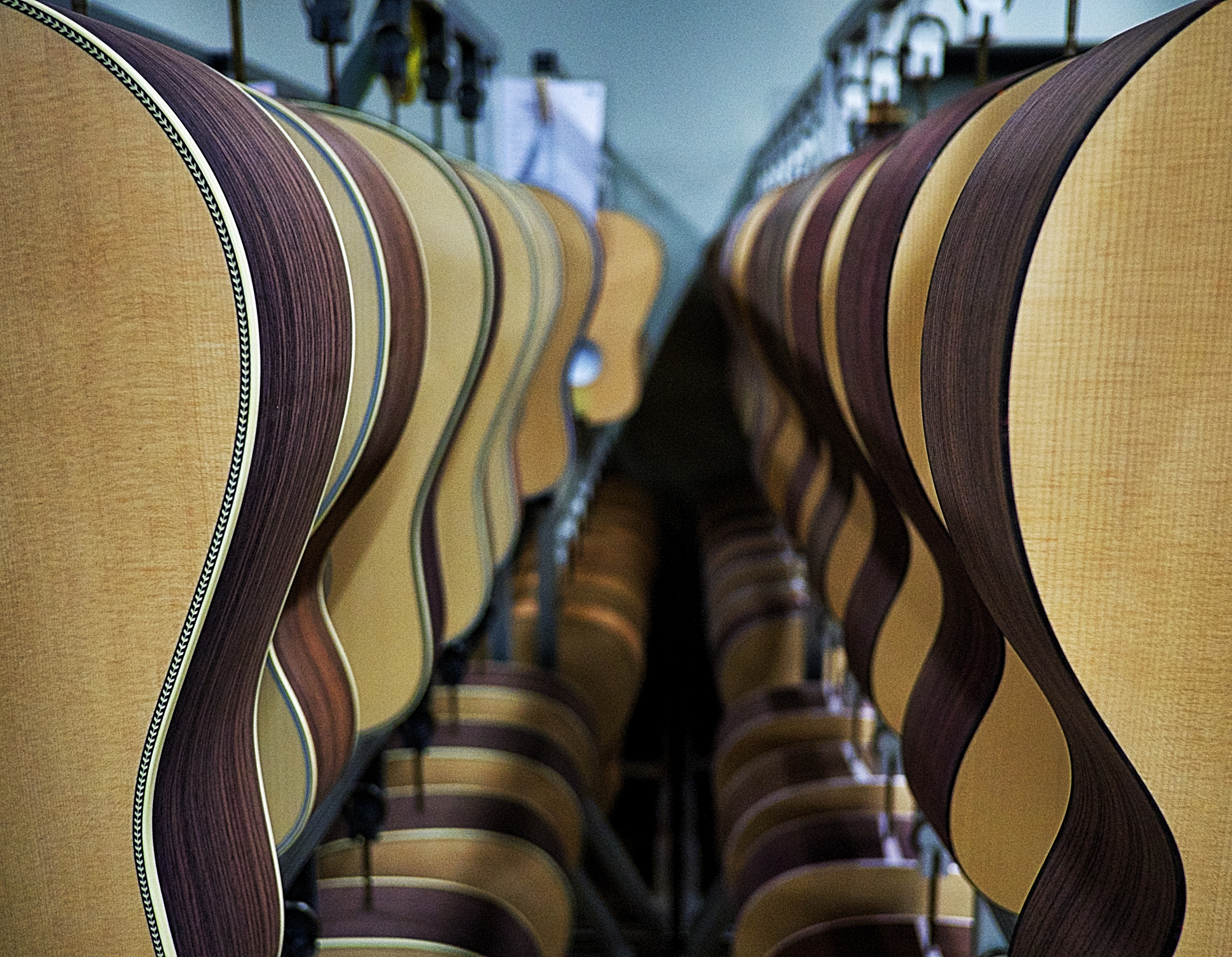
At the C.F. Martin factory in Nazareth, PA. Fuj1 X-Pro1 with 18mm lens @f/2.8. Processed with Snapseed on a Mac. See more (in black and white) here.
 Tuesday, November 12, 2013 |
Tuesday, November 12, 2013 |  Post a Comment in
Post a Comment in  photo of the week | tagged
photo of the week | tagged  18mm,
18mm,  fuji x-pro1,
fuji x-pro1,  guitar,
guitar,  martin
martin Bob Taylor on environmentalism, guitars, and food
I've cycled through a lot of different brands of guitars across the years. Although I currently have only one Taylor (a 355 that I bought in 1998), I really respect their history, designs and technologies, philosophy, and environmental positions. Here's an interesting conversation between Bob Taylor and foodie/author Alton Brown that moves from the history of Taylor Guitars to conservation, lutherie, and marketing, to vegan cooking and eating. If you've been reading my blog, you can see why these topics resonate with me right now. If you have 75 minutes, it's definitely worth a listen.
 Saturday, October 26, 2013 |
Saturday, October 26, 2013 |  Post a Comment | tagged
Post a Comment | tagged  environmentalism,
environmentalism,  food,
food,  guitar,
guitar,  taylor,
taylor,  vegetarian
vegetarian The down-low low-down: Thoughts on baritone guitars
The band I play in (as in we've had 3 gigs in 18 months!) is currently configured with three acoustic guitar players, a mandolin player and vocalist, and a multi-instrumentalist (mandolin, banjo, slide guitar, acoustic guitar); sometimes we have a bass player as well. I count as one of the acoustic guitar players, and with three of us it can be too much of the "same thing" if we're all playing in the same position. So last week I decided to change things up and brought out my Santa Cruz Bob Brozman baritone (BBB). I got a great deal on this guitar a few years back, and have primarily kept tuned down to C# (i.e., three half-steps below standard tuning) or D (two half-steps) with standard medium strings. Mine is the standard model with the back and sides made from mahogany and a sitka spruce top, rather than the pricier koa and German spruce models. Unlike the one pictured below, mine came with a factory pickguard.
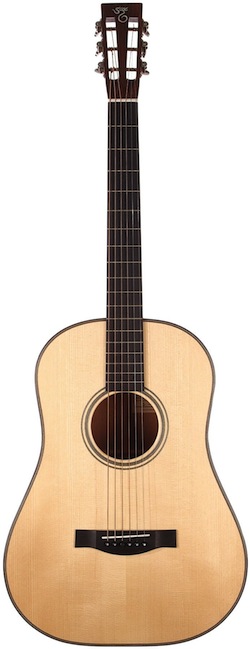 To compliment the band, I decided to throw heavier "baritone"-gauged strings on the BBB and tuned down to B. I figured that this would work best in terms of being able to play along with most of our songs while staying in common chord shapes. B is pretty low for an instrument with a 27" scale; most baritones that go down that low are 28-29". Before I got the BBB, I had a maple-bodied Tacoma baritone with a 29" scale, and I found it to be more than I could handle, both on the left hand and also in terms of the large body. So when I had the opportunity to get the BBB (at a great price), I jumped at it because it's a much more manageable instrument.
To compliment the band, I decided to throw heavier "baritone"-gauged strings on the BBB and tuned down to B. I figured that this would work best in terms of being able to play along with most of our songs while staying in common chord shapes. B is pretty low for an instrument with a 27" scale; most baritones that go down that low are 28-29". Before I got the BBB, I had a maple-bodied Tacoma baritone with a 29" scale, and I found it to be more than I could handle, both on the left hand and also in terms of the large body. So when I had the opportunity to get the BBB (at a great price), I jumped at it because it's a much more manageable instrument.
I was suprised that the BBB took the B tuning pretty well. The low B string wasn't too floppy and actually had more punch than I was expecting. It certainly doesn't blow the roof off or rumble the house's foundation, but it is satisfying and mixed in with the other instruments in the band well. So I'm well on my way to becoming my band's baritone guitar player...
Although the BBB works well, given my bouts with G.A.S., I started thinking about the other baritones out there. As well as the BBB fits the bill, I like it in C# or D tuning, and wondered if I should leave it there and find another baritone to take down to B. Since B and C#/D need different string gauges, it's not easy to go between them. Maybe I need two baritones...One for B and another for C#/D?
The Taylor Baritone is an interesting model in that it is 27" scale, designed to go down to B. There are also two models, a standard 6-string and a 8-string that includes octave strings for the 3rd and 4th strings (akin to a 12-string guitar). The idea is that the two octave strings add some "sparkle. So, in theory it would make a great second baritone since it would give a different tuning (B...so I could return the BBB to C#), has the octave strings for variety, and has a pickup (i.e., good for playing out).
I tracked an 8-string Taylor Baritone down at a local shop. I've had a few Taylors in the past, but haven't really been into them in about 10 years. I was shocked to see how much the Taylor line has expanded since I got my 355 12-string in 1998; it was overwhelming. The number of Martin models has similarly grown, although though I have (mostly) kept up with those lines. The 8-string Taylor is a really elegant guitar; it seems similarly appointed to the 800-series (i.e., rosewood, abolone rosette). At one point I was enamoured with a Taylor 814 (although I never did get one); this guitar seems like a slightly oversized version of that guitar, although it's surprisingly comfortable to play. It certainly not as cumbersome as the Tacoma baritone.
Overall, it's a nice sounding guitar. I really like the octave strings; I don't play my 355 much anymore, but this seemed to have just enough of that 12-string sound to be interesting without being overwhelming. Surprisingly (or maybe not, given the physics of such things), the low B wasn't particularly strong. My BBB hits that low note better. Other than that I enjoyed the tone of the guitar and the weak bass wouldn't be a total dealbreaker since that could be boosted when playing amplified (I assume...I didn't play with the ES pickup system that comes standard on the Baritone).
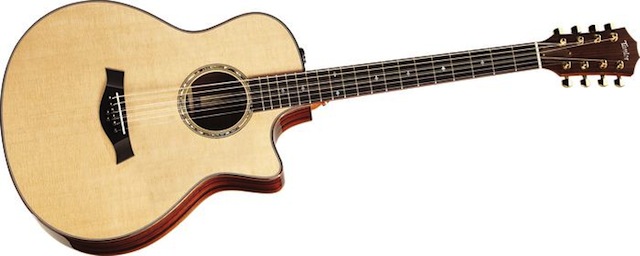
So, why didn't the Taylor Baritone come home with me? It came down to playability. First, the octave string that was paired with the 4th string buzzed whenever/however I put a capo in it. Still not a dealbreaker; I assume that could be addressed with a set up or minor adjustment. The surprising thing that made this a no-go for me was the neck width. The Taylor comes standard with 1.75" width at the nut, which is typically my preference (note: the BBB is 1-7/8"). But with those extra octave strings in squeezed in there, it just feels too cramped. With a slightly wider neck, it might have pulled the trigger. Yes, I know that Taylor has a "build to order" custom shop and probably would do a wide-necked 8-string, but I'm not quite ready to commit to that...
So, the bottom line:
- The Santa Cruz Brozman is an awsome baritone guitar. It works for my down to B with baritone gauge strings, but it really shines at C# or D with medium gauge strings.
- I like the tonal variety offered by the Taylor 8-string, although it's acoustically not as good as the SCGC BBB (but it is about half the price!). If it came with a wider neck, I'd be temped to get one and maybe let my 12-string go.
Update: 11/6/15
When I was in London last month I played a Lowden baritone guitar at No.Tom Vintage & Classic Guitars. What a fabulous instument! In particular, I found to the bass (tuned down to B) to be more defined and punchy than my Santa Cruz. I came close to pulling the trigger but ulitmately didn't do it; someone picked up a killer guitar. If you are looking for a baritone, definitely check out the offering from Lowden.
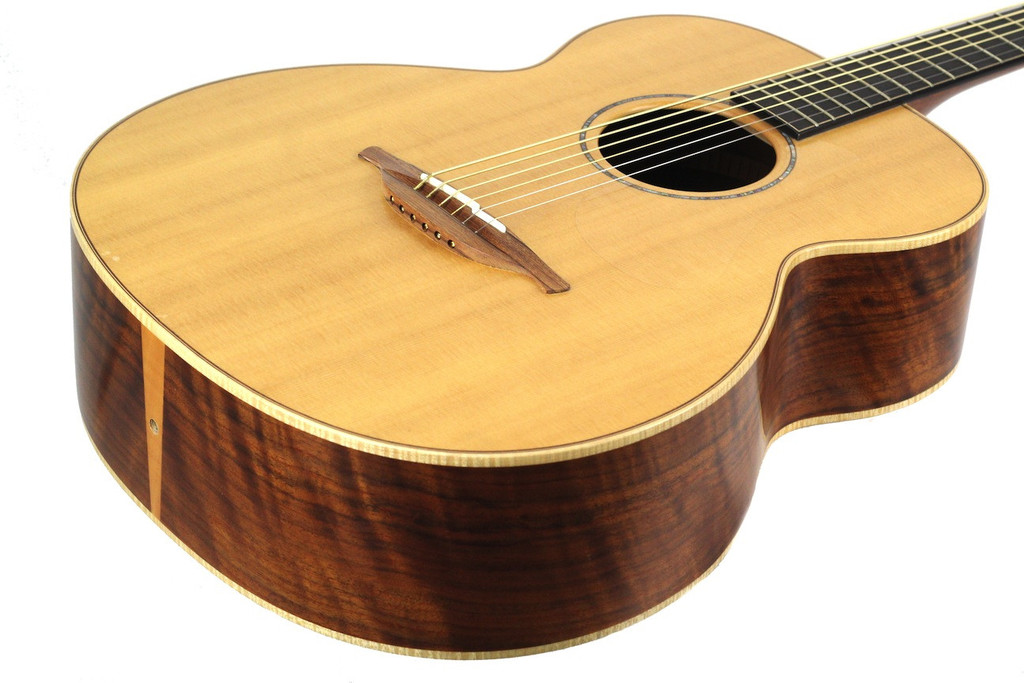 image from: http://notomguitars.com/products/2011-lowden-barritone
image from: http://notomguitars.com/products/2011-lowden-barritone
 Wednesday, October 2, 2013 |
Wednesday, October 2, 2013 |  Post a Comment | tagged
Post a Comment | tagged  baritone,
baritone,  guitar,
guitar,  santa cruz guitar company,
santa cruz guitar company,  taylor
taylor 1995 Martin D-18 Golden Era information and tracker
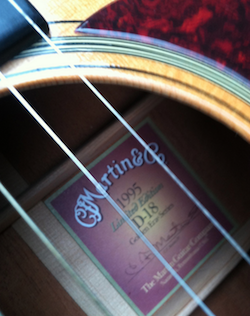 I have recently become interested in the Martin D-18 Golden Era from 1995. This was a limited edition guitar from 1995 and is not the same guitar as the "D-18GE" that has been a popular model in the Martin line-up since its introduction in 1999 (I wrote about my 2002 D-18GE previously). The 1995 Golden Era is roughly based on a 1937 D-18 and was the first Martin to bear the "Golden Era" name; it was followed the next year by the 12-fret 000-28 Golden Era and in 1998 with the 00-21 Golden Era. See an advertisement for the 1995 D-18 Golden era here (along with the 000-42 Eric Clapton model and D-35 30th anniversary edition). In addition, the good people at Martin supplied me with the spec sheet for this model. They noted the guitar was known as the "D18VGE," which is name I haven't heard before for this instrument.
I have recently become interested in the Martin D-18 Golden Era from 1995. This was a limited edition guitar from 1995 and is not the same guitar as the "D-18GE" that has been a popular model in the Martin line-up since its introduction in 1999 (I wrote about my 2002 D-18GE previously). The 1995 Golden Era is roughly based on a 1937 D-18 and was the first Martin to bear the "Golden Era" name; it was followed the next year by the 12-fret 000-28 Golden Era and in 1998 with the 00-21 Golden Era. See an advertisement for the 1995 D-18 Golden era here (along with the 000-42 Eric Clapton model and D-35 30th anniversary edition). In addition, the good people at Martin supplied me with the spec sheet for this model. They noted the guitar was known as the "D18VGE," which is name I haven't heard before for this instrument.
According to the Johnson, Boak, & Longworth (2009) reference book, the 1995 D-18 Golden Era was produced with a natural sitka spruce top (272 instruments) or sunburst top (48 instruments) and listed for $3100 ($3320 for the sunburst model). They note that:
Many features were copied directly from at 1937 D-18, including: original mahogany stain color, black binding, small abalones dot pattern on neck, Brazilian rosewood headplate with old-style decal, hot stamp burned in reinforcing center strip, cloth strips on sides, 1 3/4" V-neck, 2-5/16" spacing at bridge, long bone saddle, bone nut, chrome vintage-style tuners; other features simialr to later D-18V. This first version of the D-18GE did not have an Adirondack spruce top like the later GE Series model. (pg. 139)
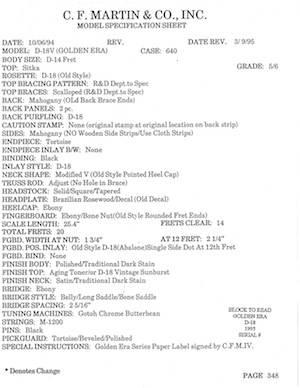 Click on the image above to see a PDF of the spec sheetAnother notable feature is that the 1995 model lacks a tongue brace (a.k.a., popsicle brace), similar to early D-18s. The sitka spruce top and lack of a tongue brace are two of the key differences with the later D-18GE (1999 to current; based on a 1934 model), which has an adirondack spuce top and includes a tongue brace.
Click on the image above to see a PDF of the spec sheetAnother notable feature is that the 1995 model lacks a tongue brace (a.k.a., popsicle brace), similar to early D-18s. The sitka spruce top and lack of a tongue brace are two of the key differences with the later D-18GE (1999 to current; based on a 1934 model), which has an adirondack spuce top and includes a tongue brace.
I find this guitar particularly interesting because 1995 is right at the up-turn in Martin production; it was among the first vintage-inspired models that have now become a staple for Martin and other manufacturers. For example, the 1985 D-18V sold 56 units, the (non-traditional) HD-18LE sold 51 in 1987, 15 1989 D-18 Specials, and 215 D-18 Vintage in 1992. In 1995, Martin built 589 "regular" D-18s and 320 of these limited edition guitars, so relatively speaking the Golden Era was a success. Maybe this showed Martin that the "lowly" D-18 could still be popular on the market and justified the development of the later "GE" series.
Click here to check out some 1995 D-18 Golden Era videos >>
Based on some sleuthing around on the internet and tracking of various guitars on ebay and guitar shop websites, and contributions from folks who have stumbled upon this page, I have started a registry of serial numbers and prices, when available, of 1995 D-18 Golden Eras:
Serial numbers known:
- 558976 - Natural - Personal communication
- 558979 - Natural - Personal communication
- 559109 - Natural - Elderly Instruments - sold, unknown date/price
- 559110 - Natural - Glen Rose Music, personal communication; also see comments below
- 559425 - Natural - Mandolin Brothers, asking price $3000
- 559426 - Natural - UMGF (9/2/13) - sold, asking price $2000
- 559427 - Sunburst - Personal communication
- 559431 - Natural - Elderly Instruments - sold, unknown date/price
- 559432 - Natural - Submitted by a reader of this post (see comments section at the bottom); was on ebay with buy it now of $2095; also was on gbase.
- 559435 - Natural - Elderly Instruments - sold, unknown date/price
- 559437 - Natural - ebay (10/20/12) unsold with starting bid of $3500 with Calton case
- 559875 - Sunburst - Craigslist (10/7/16) asking $2600
- 560214 - Natural - ebay (9/13/13) sold for $2100; posted on Craigslist (4/22/14) for $2500
- *560627 - Sunburst - Submitted by a reader of this post (see comments section at the bottom); posted for sale on Facebook for $2650 (5/29/17)
- 560896 - Natural - UMGF thread by new owner (9/28/10)
- 561835 - Sunburst - ebay (4/30/15) listed for $2700; also was on Reverb
- 562671 - Submitted by a reader of this post (see comments section at the bottom)
- 562680 - Submitted by a reader of this post (see comments section at the bottom)
- 562682 - Natural - Submitted by a reader of this post (see comments section at the bottom)
- 562692 - Natural - Personal communication
- 562696 - Natural - Personal communication
- 563002 - Natural - Submitted by a reader of this post (see comments section at the bottom)
- 563006 - Submitted by a reader of this post (see comments section at the bottom)
- 563306 - Sunburst - Elderly Instruments - sold, unknown date/price
- 564046 - Natural - submitted by a reader of this post (see comments section at the bottom)
- Listed as "5564049", which obviously isn't right. Maybe "564049"? - Natural - ebay (5/24/16) listed for $2907 in Japan; listed on Reverb (8/29/16) for ~$2300. (LINK)
Serial numbers unknown (i.e., some of these could be the same instruments and/or listed above):
- Natural - UMGF (9/10/13) asking $2000; also on Craigslist (9/11/13) asking $2500; was previously noted as acquired in April 2013 for $1800.
- Natural - Cotten Music (sold in early 2013) asking $2500
- Natural - Craigslist (8/12/13) asking $2995
- A natural and sunburst, each with some repairs, sold on the UMGF (9/12/10)
- Sunburst - Sold on UMGF (7/21/09) asking $2550.
- Natural - Craigslist (8/26/13) asking $1650.
- Natural - Sold on Acoustic Guitar Forum (9/30/13) for $1500; in "player condition."
- Natural - For sale at Janet Davis Music (10/8/13) for $2595, with some repaired top cracks.
- Natural - eBay (3/25/14) with a "buy now" price of $1949; some significant wear to the finish on the neck.
- Sunburst - Schoenberg Guitars (4/6/14) was priced at $2995.
- Natural - Greg Boyd House of Fine Instruments (4/26/14) was priced at $2850. (LINK)
- Natural - Olde Town Pickin' Parlor (7/20/14) was priced at $2400.
- Natural - Reverb (12/23/14) was priced at $2150. (LINK @ Reverb) Needs some work to address cracks and neck reset.
- Natural - Craigslist (10/22/16) asking $1500.
- *Natural - J-Guitar.com (9/16/15) priced at ¥289,440 (~$2400). (LINK) Also on ebay (12/19/15 and 6/19/16).
- Natural - Facebook (11/11/16) asking $2200 (link @ Facebook)
- *Sunburst - J-guitar.com (11/8/16) priced at ¥288,000 (LINK)
- *Natural - Reverb (5/25/17) asking $3500 $2649. Retopped with Adirondack spruce (LINK @ Reverb)
- *Natural - Craigslist (10/28/17) asking $2800 (LINK).
*For sale, at least the last time I checked...
If you have a 1995 D-18 Golden Era (or have information about one), please contact me here; I'd love to hear from you and add your guitar to the list above.
Martin (and Taylor) guitars, the seasons for bluegrass, and burritos vs. burgers, according to Google Trends
Guitar discussion boards (like the UMGF and Acoustic Guitar Forum) often devolve into brand wars..."What's better...Martin or Taylor?" with fans of each weighing in. I'm not going to get into my preferences (other than saying I've had three from each at various points in the past, and still have at least one of each), and there really isn't an answer to that question anyways. The primary questions I'm musing about here are (a) whether one of these brands has garnered more interest on the internet and (b) has that changed over time?
A third question ties into my ramblings from last week on the prospects of vintage guitars as investments, where I questioned (c) whether there would be continued interest in this instruments over the long haul.
I recently ran across the Google Trends tool...Here are the trends for "martin guitars" and "tayor guitars" (top) and "martin guitar" and "taylor guitar" (bottom):
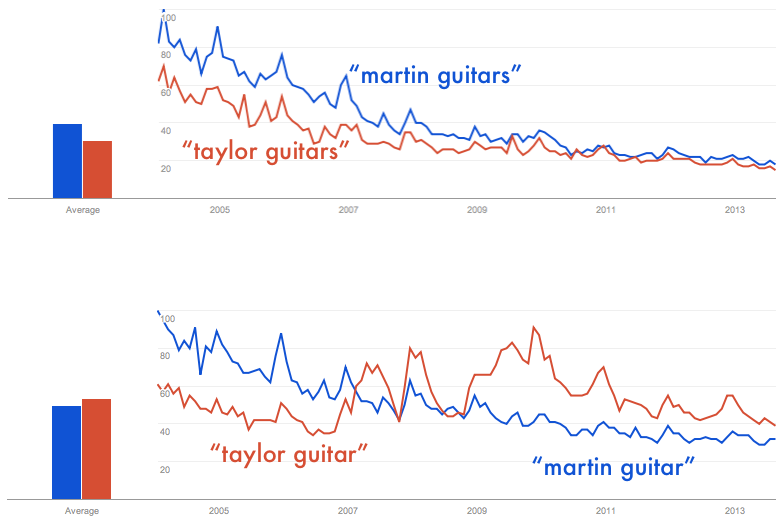
- In the top plot, Martin clearly outpaces Taylor until mid-2010 or so. Then things are pretty even. But more interestingly, both are decreasing over time. Does this indicate that people are becoming less interested in these awesome instruments over the last decade?
- In the bottom one, Martin is higher than Taylor until early 2007, then things are relatively even for a couple of years, and then Taylor takes over. These differences aren't really the product of increasing searches for "taylor guitar"-- that stays relatively flat (or at least doesn't trend one way or another, although it spikes and falls sporadically). Again, it's due to Martin slipping.
- I did versions of these plots with "gibson guitar(s)" included and Gibson outpaces both, but that's likely due do the fact they make both acoustic and electric guitars. But Gibson trends downward as well.
- In the top plot there are regular yearly spikes in December; a holiday gift effect?
- What's interesting about this is that in the last decade, Martin pumped out more instruments that ever (see here for more data). Even with Martins in the hands of more players than ever, there's less interest in them, at least using this metric.
In looking at some Martin dreadnoughts, it looks like the D-28 is still king, and that the D-18, D-35, and D-15 are pretty much similarly searched. But the entry-level DX1 comes in second; this speaks to Martin's efforts to expand their market reach with affordable instruments.
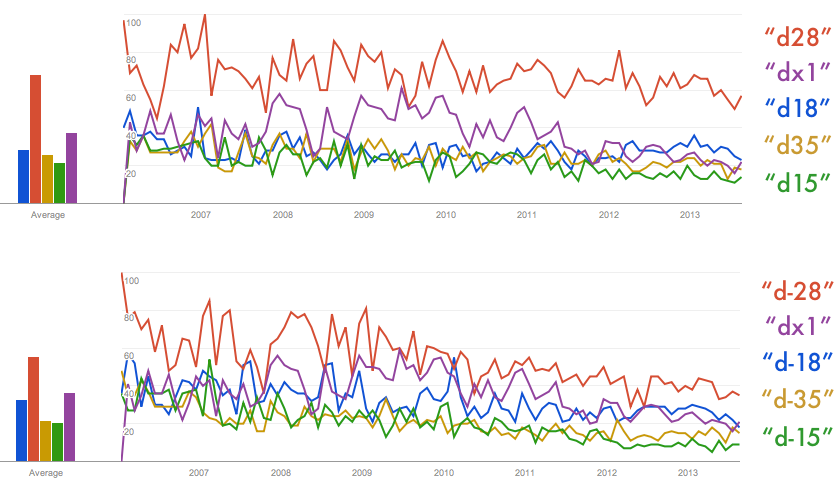
Is the guitar become less popular? Maybe a bit, but the "electric guitar" is being hit a bit harder than "acoustic guitar" (this plot clearly shows the December spike).

Here's "acoustic guitar" and "banjo" (note that if you just enter "guitar," it dwarfs "banjo"). They both are relatively flat, just trending downward a bit, and the "martin" downward slope is steeper than the general "acoustic guitar" slope. Also, "banjo" doesn't show the December spike in the same way that "acoustic guitar" does. Kids must not be asking for banjos for Christmas.

This one for "bluegrass" is cool because is so perfectly cyclical. Interest is low in November and then increases through the following summer, peaking in the height of bluegrass festival season in July and August. Then things drop in the fall season.

Just to show that some things have gone up over time, here's "facebook" (the plots for "twitter" and "iphone" are similar).

And here we see "wendys" being passed by "jimmy johns" and "chipotle".

Changing strings: Martin's Tony Rice "Monel" bluegrass strings
 I recently picked up three sets of the new Martin Tony Rice Monel strings from Elderly Instruments. My usual strings (at least on D-sized guitars) are Martin 80/20 bronze Marquis strings in medium gauge. The Monels are a nickel alloy, and at similarly gauged (the B, D, and A strings are a shade lighter than the Marquis 80/20s). Interestingly, the Monels have slightly higher string tension (184.9 pounds) than the Marquis (181.1 pounds), although they feel a bit looser/lighter than the the 80/20s. The more important question, of course, is how they sound. Well, they have been on my 1956 D-18 for a few days, and here are my initial impressions.
I recently picked up three sets of the new Martin Tony Rice Monel strings from Elderly Instruments. My usual strings (at least on D-sized guitars) are Martin 80/20 bronze Marquis strings in medium gauge. The Monels are a nickel alloy, and at similarly gauged (the B, D, and A strings are a shade lighter than the Marquis 80/20s). Interestingly, the Monels have slightly higher string tension (184.9 pounds) than the Marquis (181.1 pounds), although they feel a bit looser/lighter than the the 80/20s. The more important question, of course, is how they sound. Well, they have been on my 1956 D-18 for a few days, and here are my initial impressions.
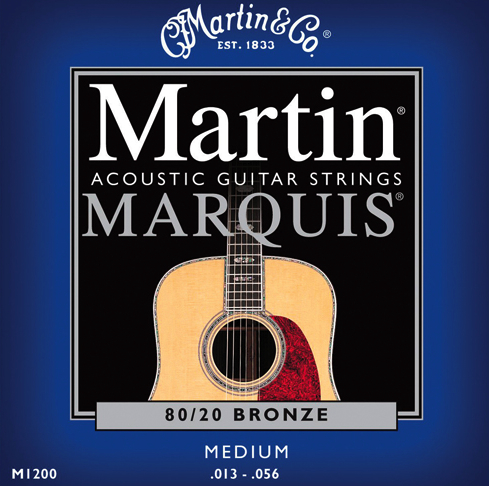 Generally, my D-18 seems to have lost its mojo with these strings. There's not the same snap, crackle, and pop with them; the sizzle and power in the guitar seems to have disappeared. The Monels sound more jangly to me, and the richness and quality in the tone has melted away. The bass is muted in favor of trebles, and this is a guitar that doesn't need to lean further in that direction. Overall the volume seems lessened and there's a thinner tone. The guitar doesn't sound "bad," but the Monels don't let this special guitar shine.
Generally, my D-18 seems to have lost its mojo with these strings. There's not the same snap, crackle, and pop with them; the sizzle and power in the guitar seems to have disappeared. The Monels sound more jangly to me, and the richness and quality in the tone has melted away. The bass is muted in favor of trebles, and this is a guitar that doesn't need to lean further in that direction. Overall the volume seems lessened and there's a thinner tone. The guitar doesn't sound "bad," but the Monels don't let this special guitar shine.
The reviews and chatter on various discussion boards seem to be about 4-to-1 in favor of Martin's new Monel strings. I still have two sets and I'll try them on some other guitars, but so far I'm in the minority that doesn't love them. The question is whether I leave them on the D-18 and play them until they need to be changed (maybe they'll get better!), or if should pull them off and put my old stand-bys back on.
Of course, your experiences may differ with your guitar, ear, and preferences. And I reserve the right to change my mind as these strings break in and/or the weather (i.e., humidity) changes...
Update: I'm still not too keen on the Monels with the D-18, but I tried a set on a Collings CJ (mahogany with an adirondack top) and they okay, at least to me, on this guitar. Some of what I said before still holds (more jangle, less bass), but that works better on the CJ than the Martin. This isn't to say that they are better than the Marquis on the CJ. Just different, but in an acceptable way. I don't have the urge to immediately go back to Marquis like with my D-18. We'll see how these strings settle in on the CJ...
Update 2: My D-18 is strung back up with medium Marquis, and it has its mojo back...
More Martin 00-DB (Jeff Tweedy signature model)
I previously wrote about this guitar, but just ran across this nice video of a 00-DB in action from the good folks at Gryphon Stringed Instruments.
And another video from Chicago Music Exchange.
And here's a video of a guy covering Van Morrison on one. A nice recording, but the guitar is plugged in so maybe not the best sense of the true tonal characteristics of it.
Vintage guitars as investments: A bump in the road or the beginning of the end?
 Disclaimer #1: I have no background in finance or experience with investing.
Disclaimer #1: I have no background in finance or experience with investing.
Disclaimer #2: Other than my "players grade" D-18, I'm not invested in vintage guitars at all, although I'd love to be in a financial position to get into this game.
I'm just thinking out loud here, and admittedly am not considering all of the relevant points involved. But I've been thinking recently about the idea of vintage guitars as an investment. I'm not sure if this is rationalization and wishful thinking (as if I ever could), or just a confluence of two interests of mine (guitars, obviously, along with retiring from working). If you follow guitar discussion boards and classified, eBay, and vintage guitar dealers, through the nineties, and up until about five years ago, vintage guitar prices were steadily climbing. I love the idea of the "42 Guitar Index" which tracks the value of 42 classic vintage instruments on the collectors' market.
But with the financial downturn, prices of vintage guitars have taken a tumble. Is this a blip? Will prices start climbing again when the economy picks back up? Rather than thinking about this from a financial perspective, I wonder whether it makes sense returning these instruments to their intended purpose...How do they represent buyers' interest in the music that these guitars make?
Here's the idea: The demand for vintage guitars is being driven by baby boomers who love classic rock and folk music of the 60s an 70s (i.e., the music that was built on Fenders, Gibsons, Martins, etc.). Boomers are a large demographic and are now to a point where they have discretionary funds to revisit their youthful obsessions. Their desire and ability to acquire vintage instruments is what fueled the skyrocketing prices. The recession hit their retirement funds and their discretionary income, and thus the subsequent dip in values. So, once things bounce back and there's more money for luxury goods like vintage guitars, will prices rebound? Here's the argument for why they won't (which I admit is not my own...I ran across it on an online guitar forum):
It's a morbid thought, but boomers won't be around forever. As they age and "fade away", the demand for vintage guitars should lessen. At the very least, the market for these guitars can't keep growing, but could conceivably shrink, depending on the musical preferences of subsequent generations (my fellow Gen-Xers). For those of us who grew up musically in the 1980's, give or take a few years, will we covet vintage guitars? I know my personal answer to that question, but what about the rest of my generation? If our musical interests are split between folk/rock/alternative and genres that are less guitar oriented (rap, electronic, pop), and we're a smaller cohort to begin with, will the demand for Les Pauls, Strats, Teles, and Martin Ds lessen?
I love vintage guitars, but if I had a lot of money tied up in them, I wouldn't be that confident that they'll bounce back. That's bad news for their wallets, but good news for people like me that want to play these beautiful instruments.
Grinnell Guitars, by Gibson
"GGG"...and not in the way that Dan Savage means.
This post pays tribute to a wonderful combination of two things I love: vintage guitars and Grinnell (College...although in reality, this doesn't have anything to do with the college). Grinnell Brothers was a music retailer in Michigan in the '30s, and much like the Kalamazoo, Recording King, Cromwell, Martelle, etc. brands, these guitars were made by Gibson. Although the general body shapes are similar to Gibson models, there are typically some structural differences like ladder (rather than X) bracing and a lack of truss rods.
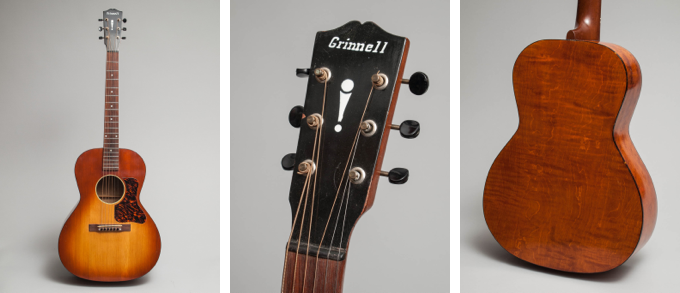
This one is a 1945 694-F from Southworth Guitars:
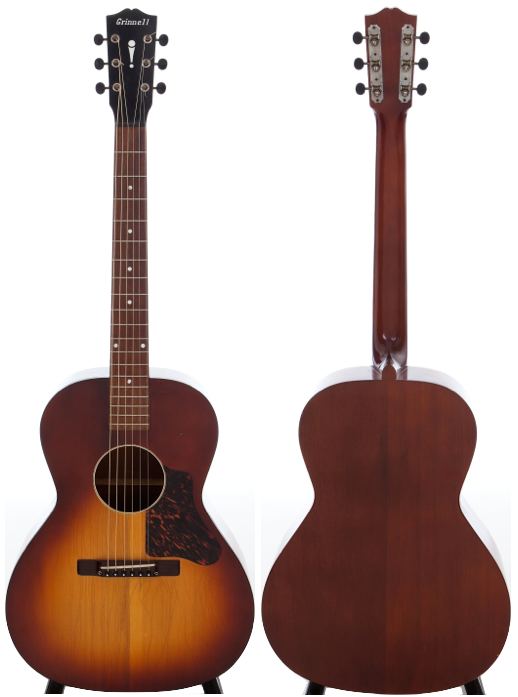
 Wednesday, April 3, 2013 |
Wednesday, April 3, 2013 |  Post a Comment | tagged
Post a Comment | tagged  daniel roberts,
daniel roberts,  gibson,
gibson,  guitar,
guitar,  santa cruz guitar company
santa cruz guitar company On big guitars and (past) shoulder pain
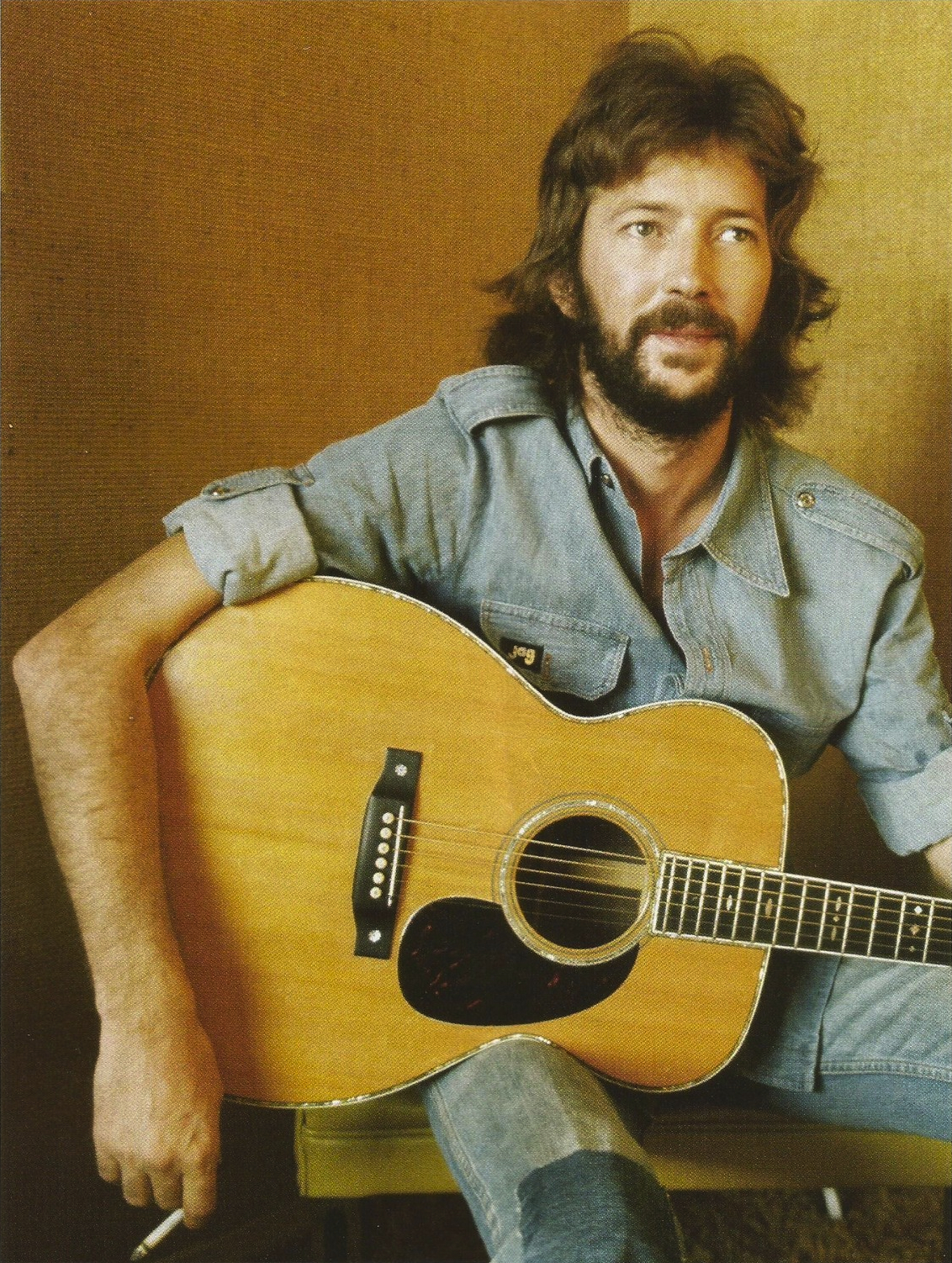 Since high school I've had on-and-off trouble with my right shoulder. I attribute it to playing too much whiffle ball as a kid. Trying to throw a plastic sphere that weighs about an ounce as hard as you can for hours on end can't be good for one's rotator cuff. Baseball as a teenager, volleyball in college, and softball in grad school didn't help things. I remember being tested by a doctor when I was in my early 20s, and he showed me that my left (non-dominant) shoulder was significantly stronger than my right.
Since high school I've had on-and-off trouble with my right shoulder. I attribute it to playing too much whiffle ball as a kid. Trying to throw a plastic sphere that weighs about an ounce as hard as you can for hours on end can't be good for one's rotator cuff. Baseball as a teenager, volleyball in college, and softball in grad school didn't help things. I remember being tested by a doctor when I was in my early 20s, and he showed me that my left (non-dominant) shoulder was significantly stronger than my right.
One place this began to manifest itself was in playing guitar; I found I'd get an achy shoulder if I played a big guitar (e.g., a dreadnought or jumbo) for any prolonged period of time. This led me down the path of a few smaller bodied guitars, like the Taylor koa 414 grand auditorium, Larrivée LS-05, Larrivée parlour, and Collings OM2HA (all now departed) that were part of that phase.
The other day I realized that, amazingly, this problem seems to have worked itself out. I've been playing bigger guitars almost exclusively for the last few years without any shoulder pain or issues at all. How could that be?
I think there are two factors:
1. A few years ago I retired from playing softball (where I had always been a left-side infielder); I haven't thrown a ball since, and also haven't had shoulder pain. A coincidence?
2. I've playing guitar standing up (with a strap) much more since I started participating in bluegrass jams. No more being slumped over the guitar while seated, which puts stress on one's shoulder. I can play for hours at a jam with no shoulder trouble at all. It's amazing what a little bit of good posture will do! I'll get a sore back from standing in one place that long, but that's another problem (that can alleviated with stretching and movement).
Although I recently have jumped back into the small guitar world with a Martin 00-DB, that was not a reaction to shoulder pain (like with past small guitar purchases). I'm happy to learn that a 30-something year old body can still heal (my experience with going over the handlebars of my bicycle at 40mph a few years ago, with hardly a bump or bruise to show for it, also was encouraging as a sign of prolonged youthfulness, but that's another story).
A window into Kevin Kopp's craft
I'm a big fan of the guitars that Kevin Kopp builds, and brace-shaping is one of the most interesting steps in guitar building, so this video really grabbed me.
Martin 00-DB: Overcoming preconceptions
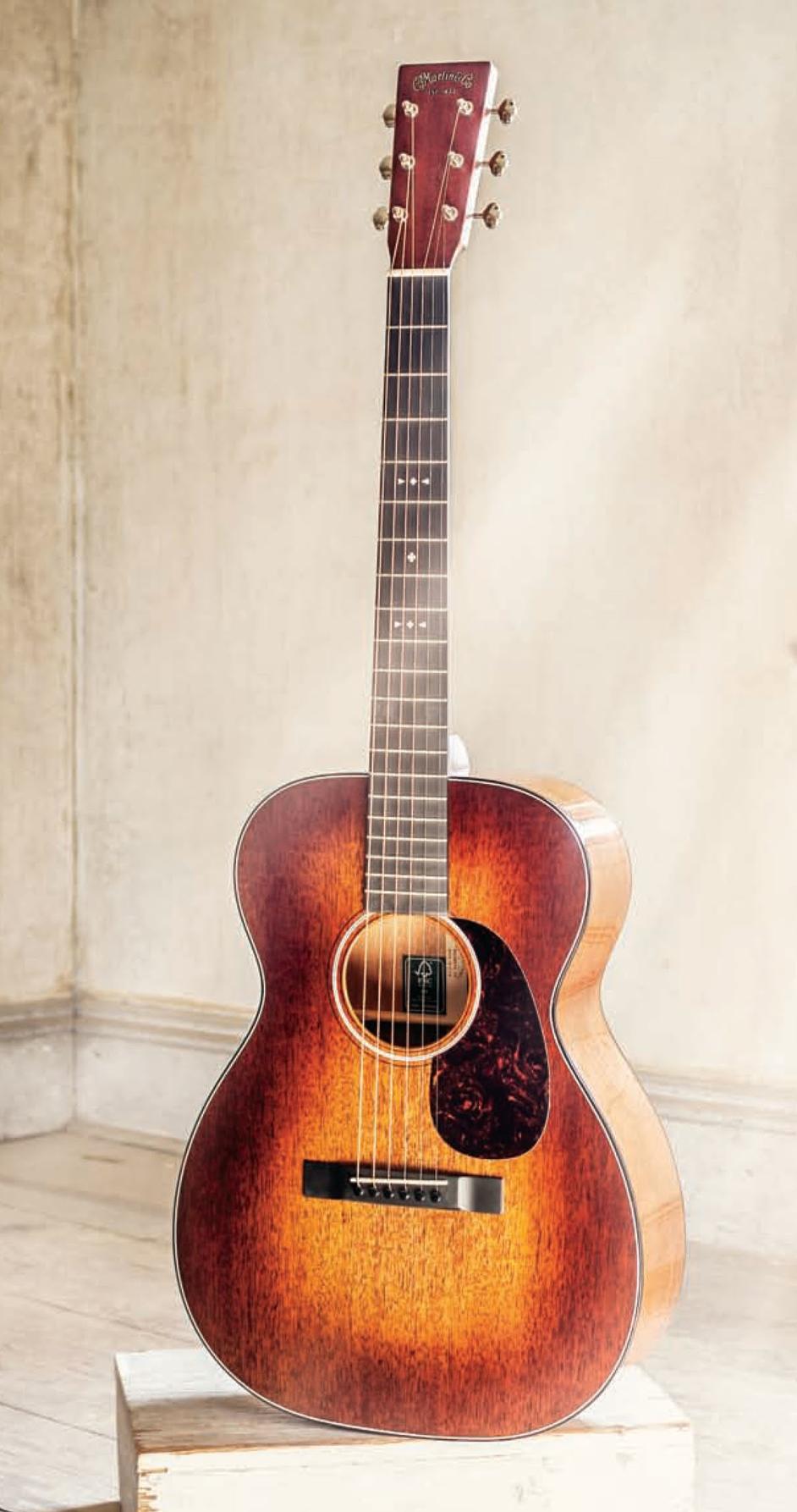 A couple of weeks ago I commented on the conservative nature of guitar players and their preferences in materials and construction techniques. Exotic tonewoods. Ebony appointments. Dovetail neck joints. Traditionally X-braced tops. And I started thinking about the use of sustainable materials in lutherie. What guitars out there have been designed and constructed with environmental concerns in mind? I started digging around and ran across a guitar that I had vaguely been aware of previously, but hadn't thought about at the time: Martin's 00-DB Jeff Tweedy signature model. I'm typically not a fan of artist-sponsored models, but this one has an understated elegance to it, and is FSC certified, fully using sustainable materials. Plus, it's got some other attributes that make it an interesting guitar...Mahogany top, sizes, and back, 00-size, deep body, 1.75" nut with a V-shaped profile. And Wilco is one of my favorite bands.
A couple of weeks ago I commented on the conservative nature of guitar players and their preferences in materials and construction techniques. Exotic tonewoods. Ebony appointments. Dovetail neck joints. Traditionally X-braced tops. And I started thinking about the use of sustainable materials in lutherie. What guitars out there have been designed and constructed with environmental concerns in mind? I started digging around and ran across a guitar that I had vaguely been aware of previously, but hadn't thought about at the time: Martin's 00-DB Jeff Tweedy signature model. I'm typically not a fan of artist-sponsored models, but this one has an understated elegance to it, and is FSC certified, fully using sustainable materials. Plus, it's got some other attributes that make it an interesting guitar...Mahogany top, sizes, and back, 00-size, deep body, 1.75" nut with a V-shaped profile. And Wilco is one of my favorite bands.
It does buck some traditional construction choices, at least by Martin standards. In particular, it doesn't use Martin's standard dovetailed neck joint; it's built with Martin's "hybrid X-bracing" rather than the bracing design that has been used by the company for a hundred years; it sports a synthetic fretbroad and bridge made of Richlite rather than ebony or rosewood.
 I've been interested in a small-bodied guitar with a mahogany top for a while, so I issued a challenge to myself (as if a guitar purchase can be considered a challenge!): could I get over my preconceptions about guitars and be open to these non-traditional features? I like the idea of supporting environmental causes with my wallet; that's not a particularly difficult challenge. But I found myself slipping back into old ways as I did my internet research...What about moving up to a Santa Cruz 00 1929, a modern guitar with its fair share of vintage features? Maybe small-bodied Collings with a mahogany top? A custom mahogany-topped Martin? After a couple of weeks of cognitively chasing these options (and mentally doubling the cost of an eventual purchase), it dawned on me that I had lost the point of this guitar: The 00-DB is cool guitar that makes use of modern design and construction choices and is a statement about environmental sustainability. So here it comes...I'm looking forward to it arriving.* Here are the specs (PDF) and an article about it in Martin's The Sounding Board newsletter (PDF; #33, July 2012).
I've been interested in a small-bodied guitar with a mahogany top for a while, so I issued a challenge to myself (as if a guitar purchase can be considered a challenge!): could I get over my preconceptions about guitars and be open to these non-traditional features? I like the idea of supporting environmental causes with my wallet; that's not a particularly difficult challenge. But I found myself slipping back into old ways as I did my internet research...What about moving up to a Santa Cruz 00 1929, a modern guitar with its fair share of vintage features? Maybe small-bodied Collings with a mahogany top? A custom mahogany-topped Martin? After a couple of weeks of cognitively chasing these options (and mentally doubling the cost of an eventual purchase), it dawned on me that I had lost the point of this guitar: The 00-DB is cool guitar that makes use of modern design and construction choices and is a statement about environmental sustainability. So here it comes...I'm looking forward to it arriving.* Here are the specs (PDF) and an article about it in Martin's The Sounding Board newsletter (PDF; #33, July 2012).
*I did play a 00-DB Jeffy Tweedy for a few minutes at a local "big-box" store where I refuse to spend money. It seems to me that this guitar is exactly opposite to the big-box store mentality. I don't understand why people shop at places like this; the prices are higher than what you can find at good independent shops and they aren't cool places to hang out. I can't comment on the sound of this guitar yet, although I enjoyed the one I played.
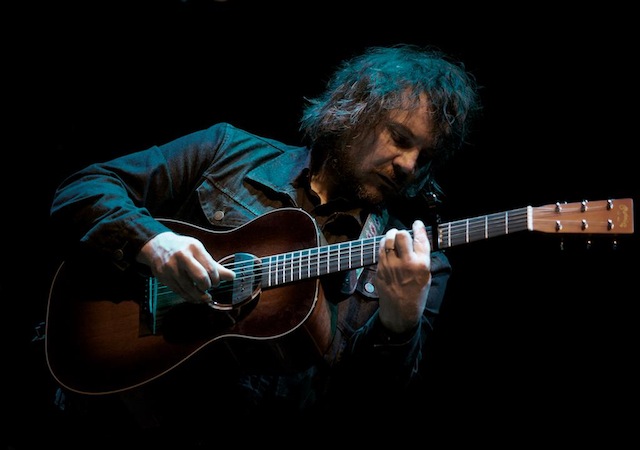 image source: http://thedailywilco.tumblr.com/post/20658381160/jeff-tweedy-playing-his-new-signature-series
image source: http://thedailywilco.tumblr.com/post/20658381160/jeff-tweedy-playing-his-new-signature-series

